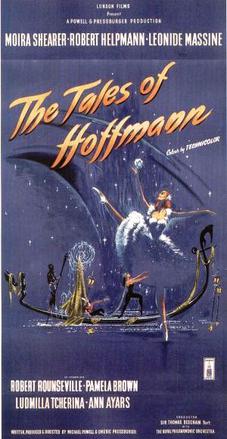 |
| Robert Helpmann and Moira Shearer in The Red Shoes |
Vicky Page: Moira Shearer
Julian Craster: Marius Goring
Boleslawsky: Robert Helpmann
Ljubov: Léonide Massine
Boronskaja: Ludmilla Tchérina
Livy: Esmond Knight
Ratov: Albert Bassermann
Prof. Palmer: Austin Trevor
Lady Neston: Irene Browne
Director: Michael Powell, Emeric Pressburger
Screenplay: Emeric Pressburger, Keith Winter, Michael Powell
Based on a story by Hans Christian Andersen
Cinematography: Jack Cardiff
Production design: Hein Heckroth
Film editing: Reginald Mills
Music: Brian Easdale
Costume design: Hein Heckroth
In its digital restoration, The Red Shoes almost certainly looks better than it ever did even in the most optimal theatrical showing, its colors brighter and sharper, its darks deeper and more detailed. But is that necessarily a good thing? I'm not like one of those audiophiles who insist that old vinyl LPs sound better than CDs or any digital audio process -- I like being able to hear things without surface pops and skips. But I do think that in the case of a film like The Red Shoes, where suspension of disbelief is essential, something has been lost. The great red snood of Moira Shearer's hair is revealed to be a thing of individual strands that might have benefited from a quick brushing before her closeups. The special-effects moments, like Vicky's leap into the red shoes or Boleslawsky's transformation into the newspaper man, are more glaringly just rudimentary jump cuts. There's a loss of glamour and magic that hasn't been compensated for, even though we can now see Jack Cardiff's photography of Hein Heckroth's designs with greater clarity. I will also admit that I have never been in the front ranks of the fans of The Red Shoes. While I admire the storytelling ability of Michael Powell and Emeric Pressburger, I have to question the moral of the story, which seems to be that a woman can't have both a great career and a successful private life, or in a larger sense, that art is impossible without a loss of self. Granted, the story comes from the realm of fairytale, which is never without an element of cruelty, but is Vicky's suicide a necessary follow-through, or just a submission on the part of the screenwriters to the demands of some kind of closure, given that they've never made the character more than a stereotype: the woman torn between the demands of two men? Ravishing to the eye, The Red Shoes doesn't satisfy the mind or the heart.
